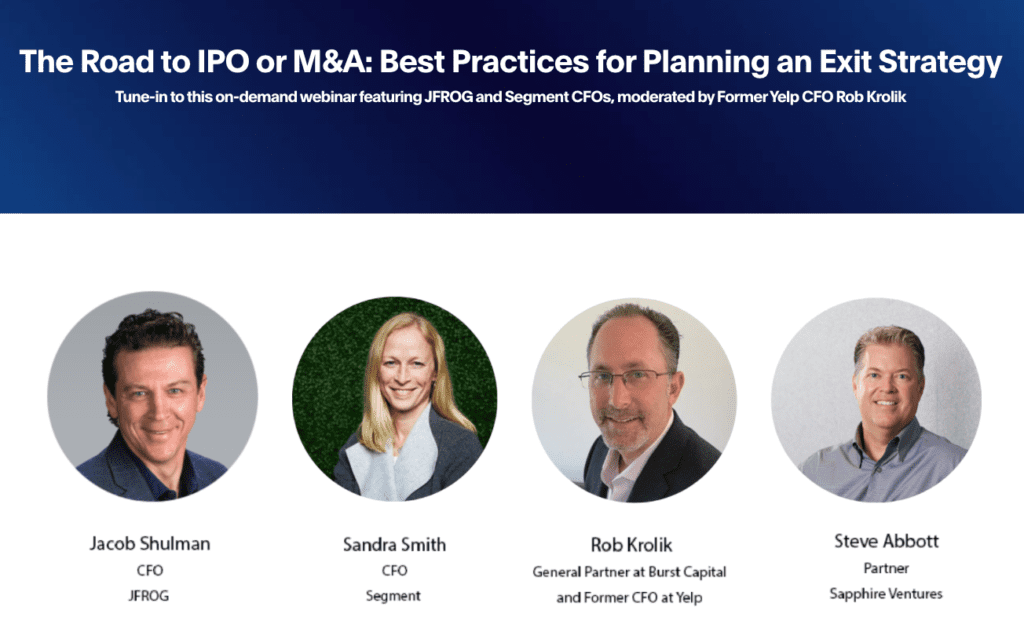When Jacob Shulman joined JFrog as CFO in May of 2018, the topic of going public wasn’t front and center. The company was growing fast and the right infrastructure was being put in place to manage growth at scale. Jacob’s appointment was primarily to ensure JFrog remained on the right track as it grew, for whatever the capital markets had in store for the company.
Two and a half years later, the company went public on Wednesday, September 16th, 2020, raising $509 million with an IPO that exceeded expectations for the developer of software tools. All this during a pandemic at that.
Sandra Smith’s appointment as CFO at Segment, however, came with very different expectations. The conversation during her hiring process was focused on readying the business for exit, and her core objectives were to implement the best practice processes and systems of a scalable and predictable SaaS business.
Just like Jacob with JFrog, Sandra is fresh from helping navigate Segment through its noteworthy recent exit: an acquisition by Twilio for approximately $3.2 billion.
But what is the secret behind delivering a successful exit strategy?
We were fortunate enough to be joined by Jacob and Sandra in a webinar last month, which was moderated by Rob Krolik, General Partner at Burst Capital and former Yelp CFO (during its IPO), Finance Fellow at Aspen Institute and longtime CFO champion.
It was an incredible conversation, which I had the privilege of introducing, packed with insightful tips and experiences as the group shared their respective journeys and fielded questions from an engaged audience of private company CFOs and other C-Suite leaders.
To recap, three key themes emerged, which I’d like to share here. And below this article, you’ll find a link to access the webinar itself on-demand.
1. Build a company of consequence
A long-term mantra of our Sapphire Ventures ethos ran through the first half of the webinar as our guests explained that whatever your eventual exit strategy looks like, it has to begin with a predictable business model, atop a solid foundation of a viable business providing a unique solution to the market.
“The board and investors were committed to scaling and growth so it was really upon me to come in and deliver the rigour and discipline to do that,” said Sandra. “We had to build a sustainable company and that began with inspecting our performance and introducing the tools and metrics to continually improve our outcomes.”
Jacob shared in Sandra’s experience, adding, “The IPO is really just a milestone and a result of doing things right, eliminating risk and putting the right things in place to grow.”
In other words, build a “company of consequence” and the successful exit will follow; it is a derivative not a primary goal in itself.
2. Think long term with your planning
When Sandra took the realm at Segment, one of the company’s focus areas for improvement was its ability to move thinking beyond the next quarter or the next half and into a much longer term view.
“When I joined Segment the business was growing well, but there really wasn’t any formal FP&A or forecasting,” explains Sandra. “Forward visibility was incredibly limited and so my primary objective was to build the discipline and the muscle within the business to go beyond planning for the next few quarters.”
This included shifting the metrics that the business was focused on to be more in line with where it wanted to be in 12 or 18 months, rather than short term objectives. This shift in approach proved essential in helping the business grow in a more sustainable way.
“JFrog was focused heavily on revenues when I joined. We hired a lot of revenue generating roles and enhanced all our revenue processes,” explains Jacob. “But, as we continued to grow and head towards IPO, we took a step back to explore more of the pre-requisites to make us a viable proposition and began engaging with investors, banks and tax experts.”
3. Build a network of investors and bankers
Ahead of any exit strategy, you need to understand the appetite and the viability of your value proposition, as well as glean any information you can from those who understand your sector, either as investors or gatekeepers to investors.
“At JFrog, we are category creators and so there really was nobody like us to compare us to,” explains Jacob. “There was a lot of education to do with investors and bankers as to our market proposition and so we had to build in that time to do the education and build a network.”
At Segment, which was already on a path towards an exit strategy, Sandra’s focus was working with the board, sharing insights and looking for more investors to help the company grow.
“All of the conversations were well underway when i joined, but we spent time fostering these relationships and doing the necessary groundwork to ensure that when the time came we were ready,” explains Sandra. “We worked with investors, the board and other independent advisors to build pitch decks and everything else we needed and stress tested our plans all the time.”
Watch the webinar in full
Whether you’re planning for an M&A exit, investigating the potential of going public or are just eager to explore this topic further, this webinar is packed full of learnings and practical advice from experts who have been there and done it. To hear what else they had to say and all of the advice they had to give on how to plan an exit strategy, make sure to watch the webinar here!





